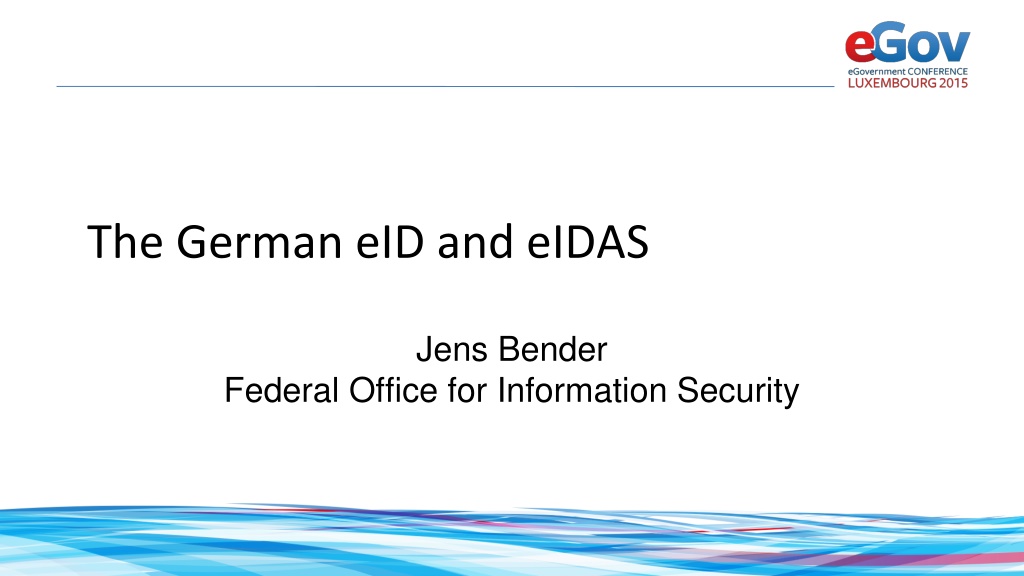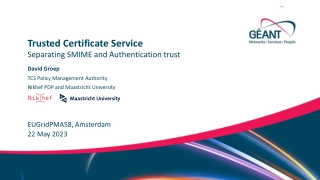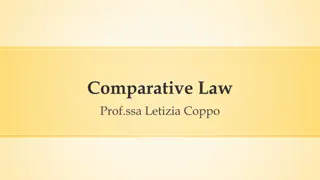German eID and eIDAS: Secure Digital Identification Overview
The German eID system, including eIDAS integration, offers secure digital identification services through government-issued ID cards with embedded chips. It allows citizens and service providers to authenticate each other securely online. The system emphasizes interoperability and privacy protection without the need for traditional ID providers or central IT security hubs. European interoperability standards are also considered for various eID schemes. Proxy-based eID schemes offer a central proxy for service providers to connect to, simplifying implementation.
Download Presentation

Please find below an Image/Link to download the presentation.
The content on the website is provided AS IS for your information and personal use only. It may not be sold, licensed, or shared on other websites without obtaining consent from the author. Download presentation by click this link. If you encounter any issues during the download, it is possible that the publisher has removed the file from their server.
E N D
Presentation Transcript
The German eID and eIDAS Jens Bender Federal Office for Information Security
Electronic Identification @ eIDAS Notification of (existing) national eID schemes No EU-eID , but mutual recognition of national eIDs Notification is not mandatory Recognition of notified eIDs is mandatory eID schemes are only affected if notified eServices are always affected Interoperability instead of harmonisation
The German eID Governmental ID Card Integrated (contactless) chip since 2010 ~ 40 Mill. issued Electronic functions Travel similar to ePassport Identification/authentication Qualified Signature
The German eID Citizen: Service Provider: Service provider proves identity using its access certifcate Can the service provider prove its identity? Is the citizen able to prove his/her identity? Both, the citizen and the service provider, have reliable proof of the identity of the other party Citizen uses eID to prove identity
The German eID Based on secure channel citizen SP As opposed to document oriented signatures Only valid in the moment of authentication Offline capable Citizen Service Provider Web Browser Web Site eID-Client Background Infrastructure eID-Server Card Reader 01.12.2015 5
The German eID No traditional ID-Provider No central IT security hot spot No central entitiy which could track citizens privacy No Service Level Agreements necessary Citizen Service Provider Web Browser Web Site eID-Client Background Infrastructure eID-Server Card Reader 01.12.2015 6
European Interoperability Many different eID schemes Smartcard based, TAN based, server based, Based on signature or secure channel or Operated by government or private sector (or both) Interop. framework must deal with all of them 01.12.2015 7
Proxy based eID scheme provides central Proxy all SPs can connect to Well suited for eID schemes already having a central entity Pro SPs needs to implement only a single interface Con No end-to-end relationship between citizen and SP Which law to use? Who is the data controller? The proxy knows everything Tracking Single Point of Failure Availability? 01.12.2015 8
Pure Middleware based eID scheme provides middleware to SPs Well suited for eID schemes having no central entity Pro End-to-end relationship (allows mutual auth.) No central component Con Service provider needs to deploy middleware 01.12.2015 9
Hybrid Middleware based eID No central component in eID scheme necessary Central deployment at receiving MS As single interface towards Service Provider SP does not need to know if the citizen uses a MW or Proxy based scheme 01.12.2015 10
Interoperability Framework Defines common interface for Proxy and Middleware Notifying MS decides on Proxy- or Middleware based notification Receiving MS decides on centralized/decentralized deployment Also semi decentralized , e.g. one Connector per sector, is possible Criteria Does a central entity already exists What fits into security/data protection philosophy National eID scheme Scalability Proxy eIDAS Connector Service Provider(s) MW 1 National eID scheme MW 2 01.12.2015 11
DE & eIDAS : eID scheme German eID is middleware based Fits into the framework Middleware to be provided to other MSs under development/testing eIDAS only deals with unique identification No pseudonymous identification, age verification, No authentication of SP only part of the German eID scheme is covered 01.12.2015 12
DE & eIDAS : Service Providers Decentralized deployment for Service Providers SPs already operate eID-Server for German eID To be extended by Connector to eIDAS Interoperability Framework Less data available via eIDAS than from German eID Not all MSs deliver name at birth, place of birth expected by eGov Many processes require address not available from all MSs Service Provider need to understand concept of LoA Adaption of business processes necessary! 01.12.2015 13
Current Status / Way forward Implementing Act for Interoperability Framework published in Official Journal Technical Specifications Drafted by Technical Subgroup of the Expert Group Opinion of the Cooperation Network and adoption Testing and Integration Sample Implementation by DIGIT under CEF Pilots Support for MSs for (technical) integration via CEF calls Which Member State will notify first? 01.12.2015 14
Long-term Hypothesis Currently: many different national eID schemes Every MS does his own thing Enforced interoperability via eIDAS regulation Hypothesis: Convergence of eID schemes will happen Due to economic, not regulatory, pressure Common standard(s) Common data model(s) and direct interoperability Cost and time-to-market reduction for industry and MS 01.12.2015 15
! ? 01.12.2015 16























